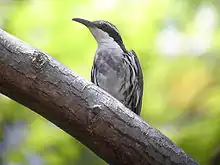Philippine creeper
The Philippine creepers or rhabdornises are small passerine birds and form the genus Rhabdornis. They are endemic to the Philippines. They do not migrate, other than to make local movements.
| Philippine creepers | |
|---|---|
 | |
| Stripe-headed rhabdornis (Rhabdornis mystacalis) | |
| Scientific classification | |
| Domain: | Eukaryota |
| Kingdom: | Animalia |
| Phylum: | Chordata |
| Clade: | Dinosauria |
| Class: | Aves |
| Order: | Passeriformes |
| Suborder: | Passeri |
| Family: | Sturnidae |
| Genus: | Rhabdornis Reichenbach, 1853 |
| Type species | |
| Meliphaga mysticalis Temminck, 1825 | |
| Species | |
|
Rhabdornis grandis | |
Taxonomy
The genus Rhabdornis was introduced in 1853 by German naturalist Ludwig Reichenbach to accommodate the stripe-headed rhabdornis.[1] The name combines the Ancient Greek rhabdos meaning "stripe" with ornis meaning "bird."[2]
The relationship of the Philippine creepers to other bird species was formerly uncertain and the genus Rhabdornis was placed in its own family Rhabdornithinae.[3][4] Molecular phylogenetic studies have revealed that the Philippine creepers are aberrant members of the starling family Sturnidae.[5][6][7]
The genus contains four species:[8]
- Stripe-headed rhabdornis, stripe-headed rhabdornis or stripe-sided rhabdornis, Rhabdornis mystacalis
- Grand rhabdornis, long-billed rhabdornis or grand rhabdornis, Rhabdornis grandis
- Stripe-breasted rhabdornis, plain-headed creeper or stripe-breasted rhabdornis, Rhabdornis inornatus
- Visayan rhabdornis, Rhabdornis rabori[9]
Description
The Philippine creepers are similar in appearance to treecreepers (Certhiidae). They have thin pointed down-curved bills, which they can use to extricate insects from bark, but they have brush-like tongues, which enable them to also feed on nectar.
References
- Reichenbach, Ludwig (1853). "Icones ad synopsin avium No. 11. Scansoriae B". Handbuch der speciellen Ornithologie (in German). Dresden und Leipzig: Expedition Vollständigsten Naturgeschichte. pp. 219–316 [276].
- Jobling, James A. (2010). The Helm Dictionary of Scientific Bird Names. London: Christopher Helm. p. 333. ISBN 978-1-4081-2501-4.
- Paynter, Raymond A. Jr, ed. (1986). Check-List of Birds of the World. Vol. 12. Cambridge, Massachusetts: Museum of Comparative Zoology. p. 161.
- Dickinson, E.C.; Christidis, L., eds. (2014). The Howard & Moore Complete Checklist of the Birds of the World. Vol. 2: Passerines (4th ed.). Eastbourne, UK: Aves Press. p. 579. ISBN 978-0-9568611-2-2.
- Cibois, Alice; Cracraft, Joel (2004). "Assessing the passerine "Tapestry": phylogenetic relationships of the Muscicapoidea inferred from nuclear DNA sequences". Molecular Phylogenetics and Evolution. 32 (1): 264–273. doi:10.1016/j.ympev.2003.12.002.
- Lovette, Irby J.; Rubenstein, Dustin R. (2007). "A comprehensive molecular phylogeny of the starlings (Aves: Sturnidae) and mockingbirds (Aves: Mimidae): Congruent mtDNA and nuclear trees for a cosmopolitan avian radiation". Molecular Phylogenetics and Evolution. 44 (3): 1031–1056. doi:10.1016/j.ympev.2007.03.017.
- Zuccon, D.; Cibois, A.; Pasquet, E.; Ericson, P.G.P. (2006). "Nuclear and mitochondrial sequence data reveal the major lineages of starlings, mynas and related taxa". Molecular Phylogenetics and Evolution. 41 (2): 333–344. doi:10.1016/j.ympev.2006.05.007.
- Gill, Frank; Donsker, David; Rasmussen, Pamela, eds. (January 2021). "Nuthatches, Wallcreeper, treecreepers, mockingbirds, starlings, oxpeckers". IOC World Bird List Version 11.1. International Ornithologists' Union. Retrieved 8 June 2021.
- "Species Updates – IOC World Bird List". Retrieved 2021-05-28.
External links
- Don Robertson's Bird Families of the World: Rhabornises. Contains photos of all 3 species. Version of 2006-JAN-25. Retrieved 2007-JUL-20.
- Flickr Field Guide: Birds of the World: Photo of Rhabdornis mystacalis. Retrieved 2007-JUL-19.